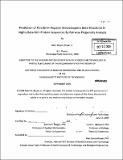Prediction of parallel in-register amyloidogenic beta-structures In highly beta-rich protein sequences by pairwise propensity analysis
Author(s)
Bryan, Allen Wayne
DownloadFull printable version (11.13Mb)
Other Contributors
Harvard University--MIT Division of Health Sciences and Technology.
Advisor
Bonnie Berger and Susan L. Lindquist.
Terms of use
Metadata
Show full item recordAbstract
Amyloids and prion proteins are clinically and biologically important beta-structures, whose supersecondary structures are difficult to determine by standard experimental or computational means. In addition, significant conformational heterogeneity is known or suspected to exist in many amyloid fibrils. Recent work has indicated the utility of templates and pairwise probabilistic statistics in betastructure prediction. A new suite of programs, BETASCAN, STITCHER, and HELIXCAP, are presented to address the problem of amyloid structure prediction. BETASCAN calculates likelihood scores for potential beta-strands and strand-pairs based on correlations observed in parallel beta-sheets. The program then determines the strands and pairs with the greatest local likelihood for all of the sequence's potential beta-structures. BETASCAN suggests multiple alternate folding patterns and assigns relative ab initio probabilities based solely on amino acid sequence, probability tables, and pre-chosen parameters. STITCHER processes the output of BETASCAN and uses dynamic programming to 'stitch' structures from flexible abstract templates defined by constraints for amyloid-like all-beta structures. The 'stitched' structures are evaluated by a free-energy-based scoring algorithm incorporating BETASCAN scores, bonuses for favorable side-chain stacking, and penalties for linker entropy. The analyses of STITCHER structures emphasize the importance of side-chain stacking ladders in amyloid formation. HELIXCAP detects a class of end-caps, called beta-helix caps, which stabilize known beta-helix structures. These structures are known to stabilize globular beta-helix proteins and prevent their amyloidogenesis; their presence in a sequence is a powerful negative predictor of amyloid potential. Together, these algorithms permit detection and structural analysis of protein amyloidogenicity from sequence data, enhancing the experimental investigation of amyloids and prion proteins.
Description
Thesis (Ph. D.)--Harvard-MIT Division of Health Sciences and Technology, 2009. Cataloged from PDF version of thesis. Includes bibliographical references (p. 123-133).
Date issued
2009Department
Harvard University--MIT Division of Health Sciences and TechnologyPublisher
Massachusetts Institute of Technology
Keywords
Harvard University--MIT Division of Health Sciences and Technology.